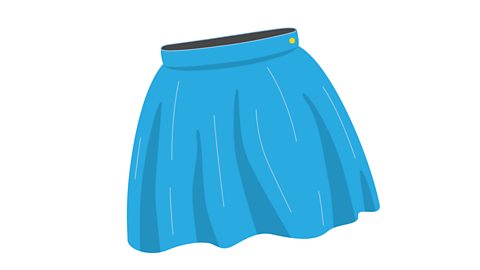Learn how to talk about colours in Spanish with these useful words and phrases.
The 1-2-3 challenge
Join Scottish pupils as they give Spanish a go!
Listen and guess what they are saying before trying yourself.
BOY 1: ¿Cuál es tu color preferido?
BOY 2: El negro.
GIRL 1: Mi color preferido es el rosa.
GIRL 2: Mi color preferido es el rojo.
Tip: This video can be used as an interactive introduction to this topic or as a recap on key vocabulary and phrases already learnt.
Remember!
It doesn't matter if your pronunciation isn't perfect. Try your best and have fun!
Colours in Spanish
Colours are adjectiveA word which describes a noun or pronoun.. They can help you describe things, such as clothes.
| Spanish | English |
|---|---|
| Sorry, something went wrongCheck your connection, refresh the page and try again. | white |
| Sorry, something went wrongCheck your connection, refresh the page and try again. | black |
| Sorry, something went wrongCheck your connection, refresh the page and try again. | red |
| Sorry, something went wrongCheck your connection, refresh the page and try again. | yellow |
| Sorry, something went wrongCheck your connection, refresh the page and try again. | purple |
| Sorry, something went wrongCheck your connection, refresh the page and try again. | brown |
| Sorry, something went wrongCheck your connection, refresh the page and try again. | blue |
| Sorry, something went wrongCheck your connection, refresh the page and try again. | green |
| Sorry, something went wrongCheck your connection, refresh the page and try again. | grey |
| Sorry, something went wrongCheck your connection, refresh the page and try again. | orange |
| Sorry, something went wrongCheck your connection, refresh the page and try again. | pink |
Favourite colours
Saying what your favourite colour is

To say 'My favourite colour is…' use the phrase:
Sorry, something went wrongCheck your connection, refresh the page and try again. + the colour
Examples:
- Sorry, something went wrongCheck your connection, refresh the page and try again. - My favourite colour is red
- Sorry, something went wrongCheck your connection, refresh the page and try again. - My favourite colour is black

Asking what someone's favourite colour is
To ask 'What is your favourite colour?' you can say:
Sorry, something went wrongCheck your connection, refresh the page and try again.
Describing things
In Spanish, all nouns are either masculine or feminine, as well as singular (when there is only one thing) or plural (when there is more than one of something).
This means an adjective (like a colour) needs to match the noun it is describing, and it does this by changing its spelling.
Here is a table of how colours change:
| Masculine singular (un) | Feminine singular (una) | Masculine plural (unos) | Feminine plural (unas) | English |
|---|---|---|---|---|
| negro | negra | negros | negras | black |
| blanco | blanca | blancos | blancas | white |
| rojo | roja | rojos | rojas | red |
| morado | morada | morados | moradas | purple |
| amarillo | amarilla | amarillos | amarillas | yellow |
| azul | azul | azules | azules | blue |
| verde | verde | verdes | verdes | green |
| łľ˛ą°ů°ůĂł˛Ô | łľ˛ą°ů°ůĂł˛Ô | łľ˛ą°ů°ůĂł˛Ôes | łľ˛ą°ů°ůĂł˛Ôes | brown |
| gris | gris | grises | grises | grey |
| naranja | naranja | naranja | naranja | orange |
| rosa | rosa | rosa | rosa | pink |
A lot of the colours follow the same pattern:
Singular nouns
Masculine noun (singular)
The colour ends in o.
- Sorry, something went wrongCheck your connection, refresh the page and try again. - a red jumper
Feminine noun (singular)
The colour ends in a.
- Sorry, something went wrongCheck your connection, refresh the page and try again. - a red skirt
As well as an o or a, the colour has an s at the end:
Masculine (plural)
- Sorry, something went wrongCheck your connection, refresh the page and try again. - two red jumpers
Feminine (plural)
- Sorry, something went wrongCheck your connection, refresh the page and try again. - two red skirts
You might have noticed that not all colours follow the patterns above. These are called 'irregular' adjectives.
Some colours only change spelling when they are plural, and a few don't change at all.

Examples:
azul only changes for plural
- Sorry, something went wrongCheck your connection, refresh the page and try again. - a blue dress
- Sorry, something went wrongCheck your connection, refresh the page and try again. - a blue skirt
- Sorry, something went wrongCheck your connection, refresh the page and try again. - blue shoes
naranja never changes
- Sorry, something went wrongCheck your connection, refresh the page and try again. - an orange dress
- Sorry, something went wrongCheck your connection, refresh the page and try again. - an orange skirt
- Sorry, something went wrongCheck your connection, refresh the page and try again. - orange shoes

More on Talking topics
Find out more by working through a topic
- count9 of 11

- count10 of 11

- count11 of 11

- count1 of 11

